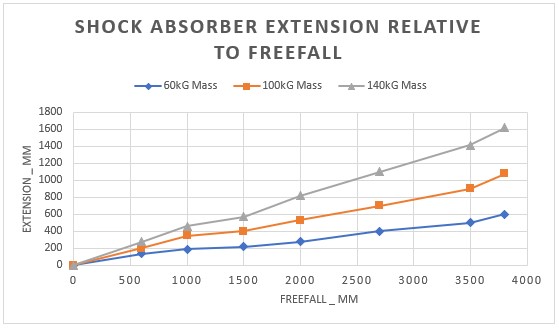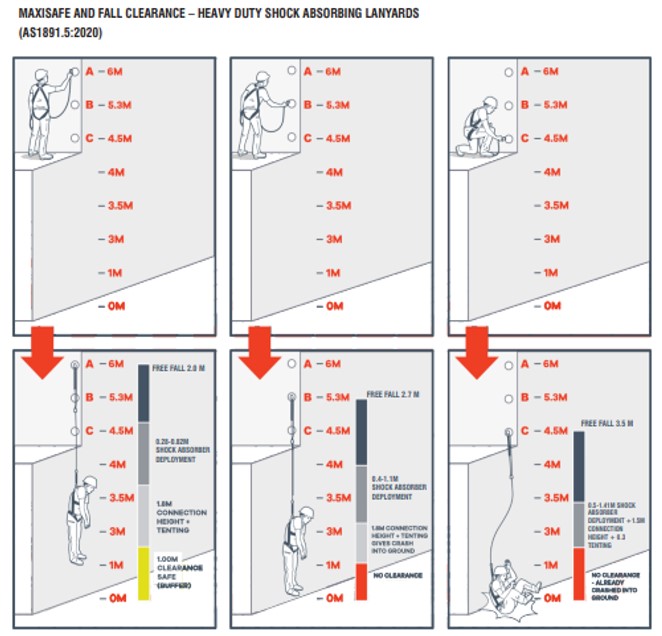
|
Maxisafe |
|---|
The evolution of protecting workers at height has seen considerable change in philosophy over the years necessitating highly effective equipment being used by highly trained users.
Users now are trained in how to keep themselves as safe as the circumstance allows by working in restraint using equipment that will still protect them in the event of a fall.
Since 1995 shock absorbers have been available in lanyards. Manufacturers in 2009 provided Australian Standards with shock absorber data (for publication) which was collated into a table showing the relationship between fall distance and shock absorber extension (for a given weight of 100kG) – the table courtesy of AS/NZS1891.4:2009
| Fall Distance MM | Shock Aborber Extension MM |
| 600 | 300 |
| 1000 | 500 |
| 1500 | 600 |
| 2000 | 900 |
Accordingly MAXISAFE took this and did extensive testing to ensure their shock absorbers complied.
Shock absorbers compliant with AS/NZS1891.4:2009 have a distinct relationship between freefall and shock absorber extension. A user of mass of 100kG (including tools) would extend the shock absorber around 900mm if they experienced a freefall of 2000mm BUT how can we use this?
Further information is provided which directs us to consider –
a) Height above attachment point above user’s feet – recommended to be taken as 1800mm (1.8m). Initially this would seem to be a little high but it is further explained that it includes a 300mm factor to account for what is termed tenting or harness movement.
(In practice when a harness pulls tight in a fall our soft tissue allows the harness to pull away from our back at the rear or front D ring (or loops) in a tent like appearance.
b) A further factor is that we should allow an additional 1000mm for the unknown.
All of the above are then to be translated into what is called FALL CLEARANCE.
Fall Clearance is the vertical distance required below an anchor point (to the nearest obstruction) that will provide the user of a given fall arrest system safety from collision with ground in the event of a fall. Additionally consideration must be given to the horizontal distance between the user and the fixed anchor point – this is done to determine if the pendulum effect will cause user to swing fall into an adjacent obstacle. (Pendulum as described is as dangerous as falling into the ground as forces are the same).
Moving to 2022 a new standard has been released – AS1891.5:2020 has given the above a new and stronger role by confirming that the mass (user) involved in the fall has a significant effect on the extension distances. MAXISAFE has now refined their products and can confidently advise the output of the tear webbing they use in their shock absorbing lanyards.
AS1891.5:2020 testing requires the user’s mass (60kG, 100kG, 140kG in MAXISAFE’S case) to be subjected to a formatted 3.8m freefall.
MAXISAFE have undertaken this significant testing with the following tabulated comparative results –

(The above information is interpolated/extrapolated from test data available at time of this document.)
MAXISAFE takes this information and makes fall clearances easy to see in the below pictorials

AS1891.5:2020 requires presentation of fall clearances required for minimum, optimum and maximum rated loads – below find Maxisafe fall clearance information:
In practice there are many possibilities when connecting a MAXISAFE 2m Heavy Duty Lanyard. HD Lanyards are rated for 60-140kG. Let’s look at three examples of each of these which summarize these –
A. Connection to anchor at shoulder level
B. Connection to anchor at waist level
C. Connection to anchor at foot level
The results of the above graphics are explained below-
A. In the event of a fall when a MAXISAFE 2m Heavy Duty Shock Absorbing Lanyard is connected at shoulder level - say 1.5m above standing level while working at height (this is same height as connection to harness)
| Rate Load | 60kg | 100kg | 140kg |
| Freefall | 2000mm | 2000mm | 2000mm |
| Shock Aborber Deployment | 280mm | 530mm | 820mm |
|
Harness tenting (tenting/stretch is where D Ring moves away from body while suspended) |
300mm | 300mm | 300mm |
| Safe Clearence | 1000mm | 1000mm | 1000mm |
| TOTAL | 3580mm | 3830mm | 4120mm |
To be safe when connecting a MAXISAFE 2m Heavy Duty Shock Absorbing Lanyard at Shoulder Level the user’s feet can vary subject to weight of user – the table below summarises –
| Weight of User (Kg) | Freefall F (mm) | Shock Aborber Deloyment E (mm) | Harness tenting (mm) | Safe Clearance (mm) | TOTAL Feet Hight above nearest obstruction (mm) | Minimum Anchor Height (F+E+2800mm) |
| 60 | 2000 | 280 | 300 | 1000 | 3580 | 5080 |
| 100 | 2000 | 530 | 300 | 1000 | 3830 | 5330 |
| 140 | 2000 | 820 | 300 | 1000 | 4120 | 5620 |
(Shock Absorber Deployment data from manufacturer’s testing)
B. In the event of a fall when a MAXISAFE 2m Heavy Duty Shock Absorbing Lanyard is connected at waist level - say 0.8m above standing level while working at height (this is 0.7m below connection point on harness) –
| Rated Load | 60KG | 100KG | 140KG |
| Freefall | 2700mm | 2700mm | 2700mm |
| Shock Aborber Deployment | 400mm | 700mm | 1100mm |
|
Harness tenting (tenting/ stretch is where D Ring move away from body while suspended) |
300mm | 300mm | 300mm |
| Safe Clearance | 1000mm | 1000mm | 1000mm |
| TOTAL | 4400mm | 4700mm | 5100mm |
To be safe when connecting a MAXISAFE 2m Heavy Duty Shock Absorbing Lanyard at waist level the user’s feet can vary subject to the weight of the user – the table below summarises –
| Weight of User (Kg) | Freefall F (mm) | Shock Aborber Deloyment E (mm) | Harness tenting (mm) | Safe Clearance (mm) | TOTAL Feet Hight above nearest obstruction (mm) | Minimum Anchor Height (F+E+2800mm) |
| 60 | 2700 | 400 | 300 | 1000 | 4400 | 5900 |
| 100 | 2700 | 700 | 300 | 1000 | 4700 | 6200 |
| 140 | 2700 | 1100 | 300 | 1000 | 5100 | 6600 |
(Shock Absorber Deployment data interpolated from manufacturer’s testing)
C. In the event of a fall when a MAXISAFE 2m Heavy Duty Shock Absorbing Lanyard is connected at foot level - say 0m above standing level while working at height (this is 1.5m below connection point on harness) –
| Rated Load | 60KG | 100KG | 140KG |
| Freefall | 3500mm | 3500mm | 3500mm |
| Shock Aborber Deployment | 500mm | 900mm | 1410mm |
|
Harness tenting (tenting/ stretch is where D Ring move away from body while suspended) |
300mm | 300mm | 300mm |
| Safe Clearance | 1000 | 1000mm | 1000mm |
| TOTAL | 5300mm | 5700mm | 6200mm |
To be safe when connecting a MAXISAFE 2m Heavy Duty Shock Absorbing Lanyard at foot level the user’s feet can vary subject to the weight of the user – the table below summarises -
| Weight of User (Kg) | Freefall F (mm) | Shock Aborber Deloyment E (mm) | Harness tenting (mm) | Safe Clearance (mm) | TOTAL Feet Hight above nearest obstruction (mm) | Minimum Anchor Height (F+E+2800mm) |
| 60 | 3500 | 500 | 300 | 1000 | 5300 | 6800 |
| 100 | 3500 | 900 | 300 | 1000 | 5700 | 7200 |
| 140 | 3500 | 1410 | 300 | 1000 | 6200 | 7700 |
(Shock Absorber Deployment data from manufacturer’s testing)
A quick review of the above reveals that irrespective of weight of user the smaller the freefall the smaller the distance from foot level to nearest obstacle can be (closer to ground). Smaller freefalls can also be achieved by –
Some interpretation to assist following observation –
Longer free fall occurs by lowering anchor point – conversely raising anchor point shortens free fall (effectively a shorter lanyard) if the higher anchor point is not available and adjustable lanyard may be used.
Look to the pictorials and see the results – MAXISAFE present this to assist users in “predicting” results of falls in circumstances they may be confronted with.
KEEP SAFE

Maxisafe acknowledges the Traditional Owners of the land where we work and live. We pay our respects to Elders past, present and emerging. We celebrate the stories, culture and traditions of Aboriginal and Torres Strait Islanders of all communities who also work and live on this land.
